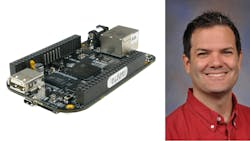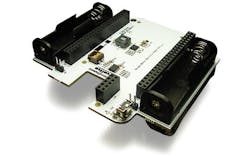Developers looking to try their hand at embedded development have a range of low cost options such as Arduino, Raspberry Pi and the BeagleBone (see Arduino, Raspberry Pi or BeagleBone?). One of the latest platforms is the BeagleBone Black (Fig. 1) that replaces the original and popular BeagleBone.
Jason Kridner is a software architecture manager for embedded processors at Texas Instruments (TI). He has done some interesting things with TI's chips and boards (watch BeagleBone and Some Fun Applications with BeagleBoard).Now, he turns his attentino to the BeagleBone Black.
Wong: What is BeagleBone Black?
Kridner: BeagleBone Black is an open-source (hardware and software) Linux computer (Fig. 1). Based on the Sitara AM335x ARM Cortex-A8 processor from Texas Instruments Incorporated (TI), BeagleBone Black runs at 1 GHz performance and is available for $45. With BeagleBone Black, everyone from hobbyists to experienced developers can take the board from the box to developing in less than five minutes.
Wong: What software does BeagleBone Black come with?
Kridner: BeagleBone Black comes pre-loaded with Yocto-compatible Ångström Distribution Linux operating system software, including Cloud9 IDE with BoneScript library that kickstarts development. The provided Linux distribution also includes a wide variety of developer tools such as a C/C++ compiler, Python interpreter, editors, build tools and hundreds of open-source libraries, including OpenCV. The board is further supported by community developers who provide many open-source software options such as Android and most major Linux distributions, including Ubuntu and Fedora.
Related Articles
- Interview With SparkFun's Director Of Engineering
- BeagleBone and Some Fun Applications with BeagleBoard
Wong: How easy is it to get started with BeagleBone Black?
Kridner: One of the best things about BeagleBone Black is the out-of-box experience. Developers have everything they need to go from box to developing in less than five minutes. Developers can simply plug the board into their computer via the USB cable (included in the box) and begin developing using the Google Chrome browser. Once plugged in, the PC will recognize the board, exposing the on-board documentation and a network interface to help you begin development immediately. Experienced users can use the provided web-based ssh client to log into the board and get access to low-level tools immediately. New developers can follow the in-browser tutorial to learn about the board capabilities through the JavaScript library as well as examine the library to build a deeper understanding of embedded Linux systems. Once developers can demonstrate success in connecting new physical computing hardware to sense and control the world around them, they can cut and paste examples into the web-based IDE and drag and drop programs into the autorun folder.
Wong: How does BeagleBone Black differ from the earlier BeagleBone?
Kridner: BeagleBone Black offers higher performance, more functionality and a lower price than the earlier BeagleBone. BeagleBone Black offers 1-GHz performance—a 280-MHz increase over the original BeagleBone. BeagleBone Black has 512-Mbyte DDR3 in memory capability compared to the 256-Mbyte DDR2 memory capability on the original BeagleBone. BeagleBone Black also offers increased functionality, including HDMI and eMMC, at almost half the price of the old board—$45!
Wong: How does the BeagleBone Black compare to similar boards?
Kridner: BeagleBone Black offers several advantages over competitive open-source computers. BeagleBone Black is truly open source because all components on the board, including TI’s Sitara AM335x processor, are commercially available, even in small quantities. This enables developers to go beyond prototyping and on to Kickstarter. Another advantage of BeagleBone Black compared to similar boards is that it runs at higher performance. For only $45, BeagleBone Black offers about 2,000 Dhrystone MIPS at 1 GHz. The board also features many high-speed peripherals, including USB 2.0, Ethernet and HDMI. Further, because BeagleBone Black and BeagleBone support the ARMv7 instruction set, which some competitor boards no longer support, users can use more software with which they are familiar. The software will run exactly as intended by project maintainers such as Ubuntu.
Wong: What is BoneScript, and how does it help developers?
Kridner: BoneScript is a node.js-based library optimized for physical computing on embedded Linux with support for BeagleBone Black. It uses Arduino-like functions written in JavaScript to simplify physical computing tasks. The BoneScript library allows developers to fully leverage the power of the 1-GHz Sitara AM335x processor and the high-level functionality provided by Linux while both abstracting and documenting the complex functionality from the programmer. The messaging capability provided by the node.js socket.io library enables JavaScript programs running in the browser to make use of the BoneScript library functions, providing interactive tutorial environments for learning the library and how to connect up dozens of physical computing hardware components.
Wong: Why should I join the BeagleBoard.org community? What if I’m new to programming?
Kridner: The key to maximizing the potential of BeagleBone Black is to tap into the wealth of information available in one of the most active communities in the industry, BeagleBoard.org. Anyone who would like to interact with other developers to learn, answer questions and share ideas can participate by utilizing the brilliant minds and contributions of open-source developers. There are forums for developers of all skill and experience levels, from students to professional developers. Just be sure to check the forums to make sure someone hasn’t already answered your question.
Related Articles
- Arduino, Raspberry Pi or BeagleBone?
- Fast, Low-Power Module Runs Off USB Connections
- Little Board And Little Modules At Design West
Wong: How can developers expand the functionality of BeagleBone Black?
Kridner: BeagleBone Black is compatible with more than 30 plug-in boards, called “capes,” with more capes to come (Fig. 2). By integrating the board with capes providing the key I/O components of 3D printers, a Geiger counter, a telerobotic submarine and more – developers can quickly get an even broader range of innovative projects up and running on BeagleBone Black.
There are also more than 300 projects registered by developers on beagleboard.org/project, many of which are open-source projects targeting BeagleBone Black. The developers are accepting contributions to expand or improve their project. You can discover the developers’ contact information through the project registry page and get involved in whatever most excites you.
Wong: What is the availability of BeagleBone Black?
Kridner: Tens of thousands of users already have their BeagleBone Black, and well over a thousand more are shipped every day. There are resources for checking distributor stock, but the best approach is to select your favorite distributor and get your board on order. All approved distributors are getting in new boards on a regular basis and will be quick to ship your order as new boards arrive.
About the Author
Jason Kridner
Software Architecture Manager for Embedded Processors
Jason Kridner is a software architecture manager for embedded processors at Texas Instruments Incorporated (TI). Kridner is also the co-founder of BeagleBoard.org where he has created open-source development tools such as BeagleBoard, BeagleBoard-xM, BeagleBone and the new BeagleBone Black. During his 20-year tenure with TI, Kridner has become an active leader in the open-source community. He has engaged audiences at a variety of industry and hardware and software developer shows, including Maker Faire, Embedded Linux Conference, Android Builders Summit, OSCON, CES, Design West, Collaboration Summit and Design East.


